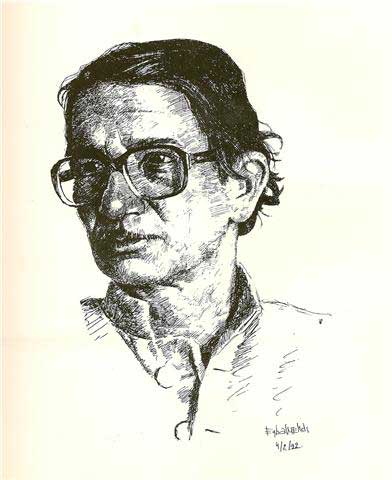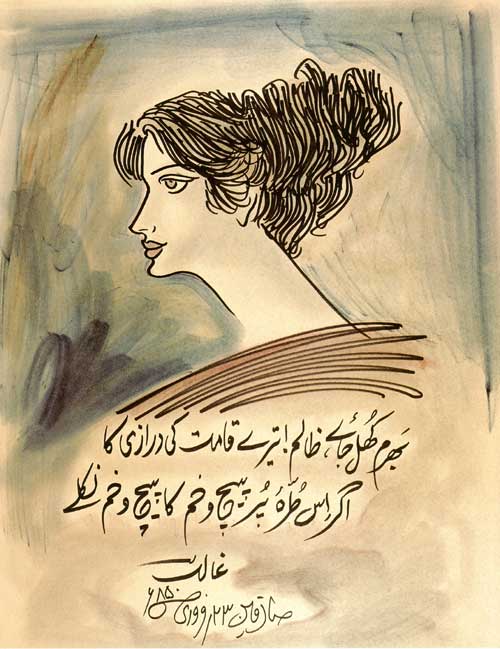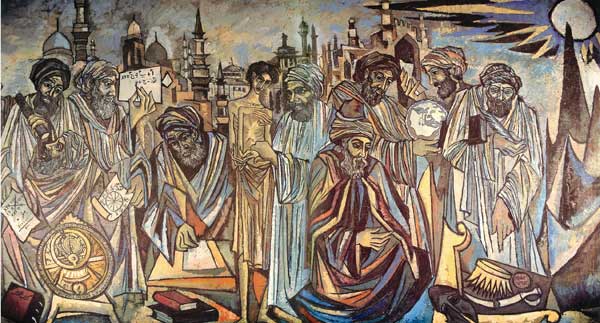Sadequain Remembered on His Twenty-second Death Anniversary
By Salman Ahmad
SADEQUAIN Foundation
San Diego , CA

Sadeuqain's sketch by Iqbal Mehdi
Sadequain breathed his last at 2:10 AM on February 10, 1987 at the OMI Clinic in Karachi. At 4:30 AM, burglars broke into Karachi’s famed Frere Hall - where Sadequain had been suffering from ill health and yet painting the gigantic ceiling of the historic site - and hauled away two Suzuki truck-loads of his paintings. The ceiling mural was left incomplete, yet lends a magnificent adornment to the Gothic structure, providing a feast for the eyes. The stolen paintings have since been surfacing at galleries and auction houses around the world, to the dismay of those who care for the artist.
If art measures the pulse of the a nation then Sadequain had his fingers on the pulse and he recorded it for posterity. In an interview he said, “People ask why I don't paint flowers, butterflies and landscapes. I tell them that I seek the truth and I am after reality. I am not inspired by someone posing against the backdrop of roses in a vase or pink curtains. What inspires me is a person who has gone hungry for hours and is struggling for survival. The expression that lights his face at the end of the day when he has finally found some scraps, that is what touches me. I am a painter of the expression of reality.”
Sadequain, as he is commonly known, was named Syed Sadequain Ahmed Naqvi, born in the city of Amroha in UP in 1930. An artist of distinction, he was uniquely different from the lot, and his multifaceted palette remains unsurpassed. His distinguished line work and flight of imagination are self-evident in his calligraphies, which he popularized amongst the masses and subsequently became a craze amongst the young artists of the country. He did not follow the traditional script, but developed his own style.
His skill and instinct made him a painter with a purpose, by employing his canvas as a message board for social commentary. In his entire career he did not wander off to portrait drawing or drifted to landscape paintings, which are the common practice boards of the artists of the era. It can be argued that Sadequain was the torchbearer of the nationalist aspirations of a nascent state that was still groping to define its identity.
His monumental murals numbering in excess of thirty-five, represent unparalleled body of artistic genius by an artist of the region. He gifted most of the murals to the public institutions.
His palette presents a vast spectrum that includes realist forms, impressionist patterns, and abstract figurations. In addition he illustrated the poetry of Ghalib, Iqbal, Faiz, and the novel, “The Stranger” by Nobel Laureate, Albert Camus. Grounded in Eastern traditions, his work embodied universal subjects and eastern forms.
According to Dr. Naqvi, a recognized art critic, “If Sadequain had done nothing but his drawings, he would still be considered the greatest artist of the country”. Sadequain also wrote thousands of quatrains (four liners) and illustrated many of them in his three volumes of “Rubaiyyats”.
Sadequain was a self-proclaimed “Faqir,” outside society’s worldly greed and hypocrisy and if he could be described in three words he would be called “speaker of truth.” By sheer talent and application, he stamped his own style on his work, which was firmly rooted in his background and cultural heritage. Strong distinctive lines, shapes, faces, figures, and colors distinguish his work.

Illustration of Ghalib's poetry
He gave away most of his work to institutions and individuals. He said to this ascribe on a number of occasions that he gifted all his work to patrons so it would be cherished and preserved, long after he is gone. Unfortunately most of his murals are in a state of dis-repair and his paintings are decaying, locked in private homes.
A significant genre of art, mural painting, is not common in the visual vocabulary of our nation. Sadequain ventured into the sphere of mural art in October of 1961, when he undertook the largest art project in the history of the nation to paint the monumental mural “Treasures of Time” (65 x 10 ft), for the library of the new building of State Bank of Pakistan in Karachi, along with eleven other pieces of artwork.
The mural is located at a public place, making it accessible to all people, regardless of class, education and ethnicity, reaching out to a much wider audience, who cannot normally have access to private studios, confined art galleries or private collectors.
The mural, “Treasures of Time”, pays tribute to the human intellectual advancement through the course of history by highlighting Greek philosophers, European luminaries of renaissance, Arab scholars, and twentieth century stalwarts complete the visual narration.
The mural pays a glowing tribute to the golden age of Islamic scholars by representing the likes of Al-Beruni, Al-Khawarizmi, Omar Khayyam, Ibne Rushd, Sadequain, IbneZakaria, Rumi, Al-Idrisi, Hafiz, and Ibne Khaldun. It is an ostentatious display of man’s intellectual progress, captured in colorful display in magnificent form. The mural is populated with characters and landmarks and appropriately delivers the rich imagery.

Section of the mural “Treasures of Time” (65 x 10 foot) pays tribute to intellectual advancement of the Arab scholars. Shown in the section are Al-Beruni, Al-Khawarizmi, Omar Khayyam, Ibne Rushd, Sadequain, IbneZakaria, Rumi, Al-Idrisi, Hafiz, and Ibne Khaldun
Other murals adorn the halls of State Bank, Frere Hall Karachi, Lahore Museum, Punjab University, Mangla Dam, Aligarh Muslim University, Banaras Hindu University, Indian Institute of Geological Sciences, Islamic Institute in Delhi, and Abu Dhabi Power House to name a few. To put it in perspective, his paintings and calligraphies in the building of Islamic Institute in Delhi cover more than seven thousand square feet.
Most murals add an element of theatrics by painting lavish landscapes, city life on the go, or the mysterious compositions of surreal figures. In many cases, conventional scenes, variety of characters and appropriate backgrounds provide the subject matter that populates the canvas. These murals provide a peek into the life of the era by capturing characters and portraying scenes from social and cultural events that take place at the time.
Through the course of history man has developed artistic instincts and used them to catalog and preserve the history of mankind for posterity. The pictorial images of the religious practices and cultural events of the society are well preserved on the walls and ceilings of the caves of Ellora in India and various venues in other parts of the world. In modern history, institutional buildings such as the Sistine Chappell replaced the caves for showcasing the artistic creativity.
It is hoped that the gift of murals Sadequain has left for the nation will be preserved for generations to come. Art institutions and other concerned organizationsought to step forward in a collective effort to save this national treasure.
SADEQUAIN Foundation is striving to raise awareness about the scope of Sadequain’s work, the plight of Sadequain’s masterpieces and catalog them to preserve his legacy. The Foundation can be contacted at sadequainfoundation@gmail.com - www.sadequainfoundation.com
-----------------------------------------------------------------------------

